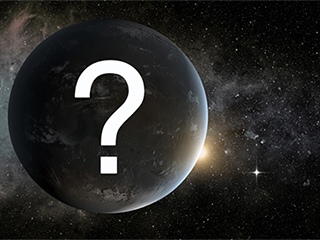News | May 14, 2020
Discovery Alert: A New Giant, Directly Imaged

Artist's rendering of Luhman 16A, a brown dwarf, showing cloud bands inferred by scientists using polarized light. It might be similar to another possible brown dwarf, TYC 8998-760-1 b, that now has been directly imaged. Image credit: Caltech/R. Hurt (IPAC)
Planet-like object: TYC 8998-760-1 b
The discovery: This object, a brown dwarf or perhaps a large planet, joins an exclusive club: those that have been directly imaged.
Key facts: Capturing pixels of light directly from planets beyond our solar system -- exoplanets -- is extremely difficult because the light from these worlds is overwhelmed by the glare from their stars. The new object joins the thin ranks of such detections. It might be a brown dwarf -- a kind of "failed star" -- that is considered neither a star nor a planet, but somewhere in between.
Details: TYC 8998-760-1 b orbits a very young, Sun-like star some 300 light-years away. The star, about the same size as our Sun, is only about 17 million years old -- a baby among stars. That means the star's companion formed only recently, and is still so hot that it gives off a powerful glow detectable by ground-based telescopes.
Fun facts: Brown dwarfs are mysterious worlds, with many unanswered questions about their properties and appearance. They're too massive to be planets, but not quite massive enough to be stars because they're unable to trigger nuclear burning in their cores. The new directly imaged object is immense, about 14 times the mass, or heft, of our own planet Jupiter, and likely three times as big around. The estimated temperature at its surface is about 2,600 degrees Fahrenheit (1,400 degrees Celsius). This object's extreme girth is unusual for brown dwarfs, and could indicate that its youthful atmosphere is highly inflated. Another possibility, which can't yet be ruled out, is that it's really two objects orbiting each other, these in turn orbiting the star. Last, the object is right on the borderline between brown dwarf and planet -- and, with further observation, could turn out to be a planet after all.
Although thousands of exoplanets have been detected in our galaxy using ground and space-based telescopes, astronomers find the overwhelming majority of them through indirect means -- watching for wobbles a star makes as it's tugged back and forth by the gravity of an orbiting planet, or tracing the tiny dip in starlight as a planet crosses the face of its star. Far fewer such objects, including large, young exoplanets and brown dwarfs, have been found by direct imaging.
The discoverers: An international team of astronomers led by Alexander Bohn of Leiden University in the Netherlands discovered the new object, TYC 8998-760-1 b, using the Very Large Telescope (VLT), operated by the European Southern Observatory in Chile. The observations of this sub-stellar (smaller than star-sized) companion were carried out using the VLT's SPHERE exoplanet imager and its NACO adaptive optics system. The object was entered into NASA's Exoplanet Archive in April.
The discovery is part of the Young Suns Exoplanet Survey of 70 young stars about the same mass as our Sun in a huge, relatively nearby stellar group, called Scorpius-Centaurus, which contains thousands of stars.











